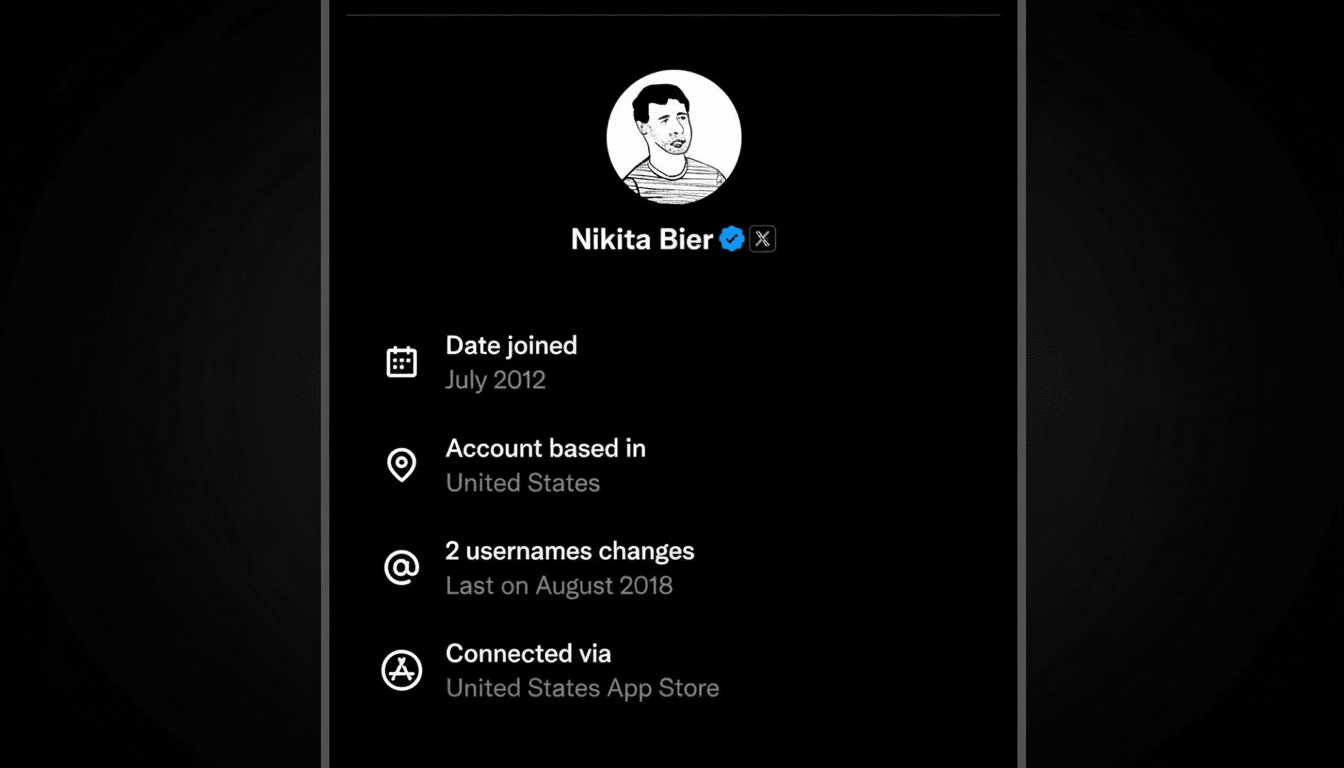X has started affixing an “Account based in” country label to profile pages — a modest but consequential tweak that is already exposing fake personas and foreign-run engagement farms. The new disclosure is located within the “About this account” panel, and for many users, it is reframing ongoing debates regarding which people are actually responsible for viral posts each day.
The feature rollout, spearheaded by X product lead Nikita Bier, was briefly halted as the company made adjustments for VPN edge cases before re-releasing it across the platform. While X hasn’t publicly disclosed all the signals it’s using, this appears to be based on network and account metadata, and both does and doesn’t show a specific country or broader region (again, depending on user settings).

How the new ‘Based in’ label works across profiles
Users also can opt to display just a general region like North America or Europe, instead of any country in particular, a privacy guardrail for individuals at risk of doxxing or residing under repressive regimes. Even so, the underlying system continues to locate, offering everyone else a stronger signal about where a posting is coming from.
That signal is not a GPS pin. (Its veracity is probabilistic: If you’re speaking English, and you use a virtual private network to obscure your connection to the internet, it might be 60 percent accurate; if not, maybe 90 percent.) VPNs and large-enterprise domains are harder for these systems to manage. Yet surfaced at scale, it introduces a layer of provenance that for years has been opaque to regular users while proving crucial for researchers studying manipulation.
Early Clues About Inauthentic Networks
Within hours of the feature’s rollout, users were sharing screenshots of patriotic United States-branded accounts that the label identified as posting from South Asia or West Africa. And some discovered “local news” characters created for American cities and run, in reality, from abroad. The strategy is reminiscent of the engagement-farm playbook: Go after hot-button issues, reap the attention, monetize the attention.
None of this exists in isolation. Twitter’s public archive had previously detailed state-linked operations at scale, including a 32,242-account takedown connected to networks based in China, Russia and Turkey. Research outfits including Graphika and the Stanford Internet Observatory have chronicled years of influence campaigns originating in Iran, Saudi Arabia, India and Russia that mixed authentic users with coordinated inauthentic activity.
Private-sector analysts have seen similar fingerprints on X since its management overhaul. Firm-level case studies from companies like Cyabra and Alethea have shown double-digit portions of suspected inauthentic accounts within particular political streams, often 10–20%, varying from subject to timing to sample. And the European Commission has pointed to X as having a relatively high rate of disinformation in its assessments of platform risk under the bloc’s rules on content.
What the location label can and cannot reliably prove
A national identity is not a judgment. Diaspora communities, expats and international marketing teams can genuinely discuss politics or culture beyond their home markets. (MAPS description of publication policies) If it’s a location, though, that journalists or open-source investigators or activists are worried might get people killed, and it was gathered in some kind of potentially insecure setting (or like easily geolocated), then you can apply to make the photographer/author share credit for protection. On the contrary, organized networks have the ability to direct traffic through residential proxies in such a way as to appear that it comes from a specific country.

Think of “based in” as a hint you can use to help yourself verify the answer. It’s significant when combined with behavioral signals: posting in unison across multiple accounts; using the exact same language and text; extremely rapid spikes of interest that can’t be easily explained as “this video happened to go viral”; graphs of followers dominated by either recently created or low-quality profiles. The label in itself should not be used as a means to dox or harass people.
Implications for moderation, policy, and transparency
For researchers and newsrooms, the feature also lowers the barrier to doing precursors of provenance checks, and could speed up discovery of cross-border influence clusters. It provides advertisers with a rapid sanity check on brand safety in replies. And for regulators, it directs X toward the transparency that some have baked into frameworks like the E.U.’s Digital Services Act, which calls on very large platforms to look carefully for systemic risks and try to address them.
It’s also a test for X of its commitment to dealing with bots and spam. A visible location tag provides community oversight, but opponents quickly adjust. Look for moves by brands to region-only labels, more advanced traffic routing, and badged domestic accounts that bypass location checks.
How to Use the Signal Without Overreaching
Before calling something a bot, triangulate. Cross-reference posting times with claimed location; hunt for linguistic tics and translation artifacts; reverse-image-search avatars; verify account age, past handles and response-network repetition. Academic tools like the one developed by Indiana University, Botometer, can provide a probabilistic score, but none of them offer hard-and-fast certainty.
Above all, concentrate on behavior, not nationhood. Disinformation is a means, not an origin. The “based in” label should inform you on how to weigh credibility and context, but not serve as a shorthand for suspicion.
Bottom line: what this change means for users and X
X’s country label will not remove fake accounts, but it significantly increases the cost of running deceitful personas at scale. By surfacing where posts are coming from, it aids users and researchers in detecting mismatches between identity and activity. Another test is whether X combines this transparency with firm enforcement and data that make the platform more difficult to game.

